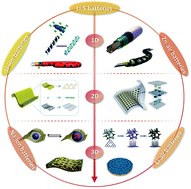当前位置:
X-MOL 学术
›
J. Mater. Chem. A
›
论文详情
Our official English website, www.x-mol.net, welcomes your feedback! (Note: you will need to create a separate account there.)
Innovation and challenges in materials design for flexible rechargeable batteries: from 1D to 3D†
Journal of Materials Chemistry A ( IF 11.9 ) Pub Date : 2017-12-05 00:00:00 , DOI: 10.1039/c7ta09301b Yanghua He 1, 2, 3, 4, 5 , Bryan Matthews 1, 2, 3, 4, 5 , Jingyun Wang 1, 2, 3, 4, 5 , Li Song 1, 2, 3, 4, 5 , Xiaoxia Wang 1, 2, 3, 4, 5 , Gang Wu 1, 2, 3, 4, 5
Journal of Materials Chemistry A ( IF 11.9 ) Pub Date : 2017-12-05 00:00:00 , DOI: 10.1039/c7ta09301b Yanghua He 1, 2, 3, 4, 5 , Bryan Matthews 1, 2, 3, 4, 5 , Jingyun Wang 1, 2, 3, 4, 5 , Li Song 1, 2, 3, 4, 5 , Xiaoxia Wang 1, 2, 3, 4, 5 , Gang Wu 1, 2, 3, 4, 5
Affiliation

|
Due to the emergence of numerous flexible electronic devices, the design and fabrication of flexible power sources with high energy density have attracted great attention in the field. Among various energy storage technologies, flexible rechargeable batteries are the most promising, because of their unique features including high flexibility, high specific energy density, light weight properties, etc. To achieve the flexible battery concept, the flexibility of each component is considered a key property in addition to required electrochemical capacity and stability. In this review, recent advances in different kinds of flexible rechargeable batteries are discussed, including lithium-ion batteries (LIBs), lithium–sulfur (Li–S) batteries, lithium–air (Li–air) batteries, zinc–air batteries (ZABs), and sodium–ion batteries (SIBs). Based on the macro-shapes and micro-structures, flexible batteries are outlined into one-, two-, and three-dimensional. Further, sub-classification is performed within each type according to the role of materials in various batteries such as anodes, cathodes, electrolytes, and other components. It is important to note that the design for flexibility is also influenced by the assembly process of all of material components. Thus, this review focuses not only on the selection and preparation of battery materials, but also on the complete battery assembly process. Since some experimental data for flexible batteries are still limited by today's technology, performance simulations have also been included to predict and describe the battery performance. Finally, key challenges and perspectives for advanced flexible battery technologies are provided as general guidance for future research.
中文翻译:

柔性可充电电池材料设计的创新与挑战:从一维到三维†
由于大量的柔性电子设备的出现,具有高能量密度的柔性电源的设计和制造在该领域引起了极大的关注。在各种储能技术中,柔性可再充电电池是最有前途的,因为其独特的功能包括高柔韧性,高比能量密度,轻质特性等。为了实现柔性电池概念,除了所需的电化学容量和稳定性之外,每个组件的柔性都被认为是关键特性。在这篇综述中,讨论了各种柔性充电电池的最新进展,包括锂离子电池(LIB),锂硫(Li–S)电池,锂空气(Li–air)电池,锌空气电池( ZAB和钠离子电池(SIB)。基于宏观形状和微观结构,柔性电池被概述为一维,二维和三维。此外,根据各种电池(例如阳极,阴极,电解质和其他组件)中材料的作用,在每种类型内执行子分类。重要的是要注意,灵活性设计还受所有材料组件的组装过程影响。因此,本文不仅着眼于电池材料的选择和制备,还着眼于完整的电池组装过程。由于柔性电池的一些实验数据仍受当今技术的限制,因此还包含了性能仿真来预测和描述电池性能。最后,提供了高级柔性电池技术的主要挑战和前景,作为未来研究的一般指导。
更新日期:2017-12-05
中文翻译:

柔性可充电电池材料设计的创新与挑战:从一维到三维†
由于大量的柔性电子设备的出现,具有高能量密度的柔性电源的设计和制造在该领域引起了极大的关注。在各种储能技术中,柔性可再充电电池是最有前途的,因为其独特的功能包括高柔韧性,高比能量密度,轻质特性等。为了实现柔性电池概念,除了所需的电化学容量和稳定性之外,每个组件的柔性都被认为是关键特性。在这篇综述中,讨论了各种柔性充电电池的最新进展,包括锂离子电池(LIB),锂硫(Li–S)电池,锂空气(Li–air)电池,锌空气电池( ZAB和钠离子电池(SIB)。基于宏观形状和微观结构,柔性电池被概述为一维,二维和三维。此外,根据各种电池(例如阳极,阴极,电解质和其他组件)中材料的作用,在每种类型内执行子分类。重要的是要注意,灵活性设计还受所有材料组件的组装过程影响。因此,本文不仅着眼于电池材料的选择和制备,还着眼于完整的电池组装过程。由于柔性电池的一些实验数据仍受当今技术的限制,因此还包含了性能仿真来预测和描述电池性能。最后,提供了高级柔性电池技术的主要挑战和前景,作为未来研究的一般指导。


























 京公网安备 11010802027423号
京公网安备 11010802027423号